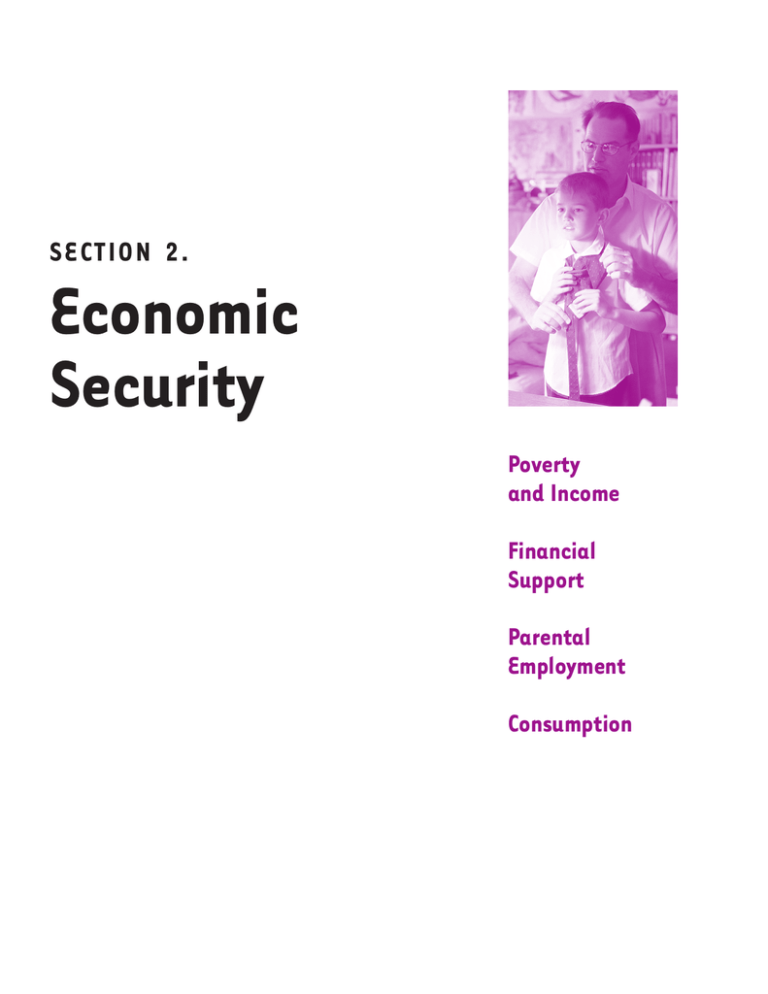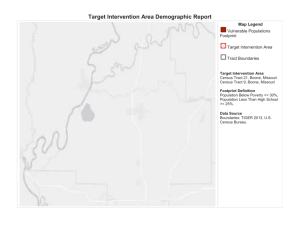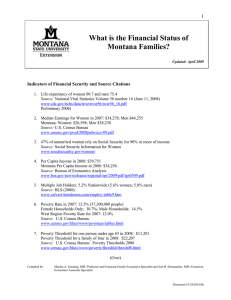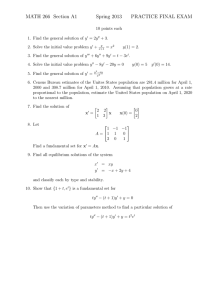Document 13959302
advertisement

SECTION 2. Economic Security Poverty and Income Financial Support Parental Employment Consumption SECTION 2. ECONOMIC SECURITY Poverty and Income Financial Support Parental Employment Consumption Poverty and Income ES 1.1 Median Family Income The median income1 of families with children is a good starting point for assessing the eco­ nomic well­being of children, since it measures the ability of a family at the midpoint of the income distribution to purchase food, shelter, clothing, child care, medical care, and other basic goods and services required to raise a child.2 However, median family income fails to capture important economic resources that may also be available to a family, such as employer­paid health benefits, Medicaid, or Food Stamps; moreover, it says nothing about changes in the distribution of income across families. For a more complete picture of children’s economic well­being, it is necessary to look at several measures of economic well­ being, including those in the following indicators. Between 1980 and 2002, median income of all families with children increased from $44,179 in 1980 to $51,760 in 1999 before decreasing to $50,851 in 2002 (Table ES 1.1). Differences by Family Type. Throughout the period from 1980 through 2002, median income of mother­only families has never exceeded 35 percent of median income of two­ parent families (see Figure ES 1.1). In 2002, the median family income of mother­only fam­ ilies was $22,637, compared with $65,399 for married­couple families with children. During the same time period, the median income of father­only families never exceeded 62 percent of median income of two­parent families (Figure ES 1.1). In 2002, median income of father­only families was $32,154. Differences by Race and Hispanic Origin.3 Median family incomes are substantially higher for White only , non­Hispanic families with children than for Black only or Hispanic families with children. In 2002, median incomes of White only, non­Hispanic families were about 98 percent higher than those of Black only families and 90 percent higher than those of Hispanic families (Table ES 1.1). 1 Median income is the amount that divides the income distribution into two equal groups, half with incomes above the median, half with incomes below, as defined by the U.S. Census Bureau in the March 2003 Current Population Survey. It is computed in constant 2002 dollars using the Bureau of Labor Statistics’ CPI­U­RS Consumer Price Index. 2 When median family income is rising, the likelihood is that children in a typical family are enjoying a rising standard of living. 3 Racial categories for 2002 differ from those of previous years due to the addition of the multiple race category on the 2000 Census. 76 Trends in the Well­Being of America’s Children and Youth 2003 SECTION 2. ECONOMIC SECURITY Table ES 1.1 Median income of families with related children under age 18, by race and Hispanic origin, and family type: Selected years, 1980­2002 1980 1985a 1990 1995b 1996 1997 1998 1999 2000c 2001 2002d All families All races $44,179 $44,178 $45,685 $46,908 $46,788 $48,671 $50,086 $51,760 $52,960 $51,819 $50,851 White, non­Hispanic — — $51,452 $54,479 $54,971 $56,946 $58,381 $61,138 $62,759 $61,851 $61,145 Black — — $25,837 $26,575 $26,155 $28,206 $28,482 $29,986 $31,815 $30,832 $30,921 Hispanice — — $29,366 $27,040 $28,105 $29,195 $30,577 $33,441 $34,111 $33,613 $32,172 Married­couple families All races $50,260 $51,583 $55,068 $58,575 $59,098 $60,798 $62,850 $64,950 $65,943 $66,263 $65,399 White, non­Hispanic — — $57,878 $62,170 $63,569 $65,842 $67,819 $70,004 $72,209 $72,258 $72,133 Black — — $47,675 $51,514 $48,742 $53,238 $53,496 $55,059 $54,544 $56,640 $56,863 Hispanice — — $36,668 $34,784 $36,087 $37,145 $37,743 $40,072 $41,805 $41,200 $39,617 Mother­only families All races $17,502 $16,067 $17,474 $19,032 $18,709 $19,288 $20,291 $21,518 $22,893 $22,355 $22,637 White, non­Hispanic — — $21,518 $24,361 $23,373 $23,497 $24,944 $26,319 $27,427 $25,869 $26,337 Black — — $13,755 $15,226 $15,579 $16,890 $16,926 $17,262 $19,735 $19,396 $19,189 Hispanice — — $13,536 $13,839 $12,832 $14,511 $15,522 $17,854 $19,050 $19,330 $19,453 — — $33,648 $31,638 $30,253 $32,043 $34,023 $35,005 $33,933 $32,451 $32,154 White, non­Hispanic — — $35,802 $34,876 $33,539 $35,764 $39,196 $39,486 $38,306 $36,108 $35,953 Black — — $27,447 $26,157 $25,374 $24,383 $27,568 $32,403 $31,528 $29,111 $26,233 Hispanice — — $27,728 $22,863 $25,746 $22,385 $27,181 $27,502 $28,458 $27,830 $26,756 Father­only families All races a Recording of amounts for earnings from longest job were increased to $299,999. Data reflect full implementation of 1980 census­ based sample design. b Data reflect full implementation of 1990 census­based sample design and metropolitan definitions, 7,000 household sample reduction, and revised race edits. c Data reflect implementation for Census 2000­based population controls and the sample expanded by 28,000 households. d Racial categories for 2002 differ from those of previous years due to the addition of the multiple race category on the 2000 Census. e In 2002, this racial category contains only persons who did not select any additional racial categories on the 2000 Census. Persons of Hispanic origin may be of any race. — Data not available. Note: Median income is the amount that divides the income distribution into two equal groups, half with income above the median, and half with income below. Income statistics have been converted to constant 2002 dollars using the Bureau of Labor Statistics’ CPI­U­RS Consumer Price Index. Source: U.S. Census Bureau. (2004). Historical Income Tables. Current Population Reports, March 1981­2002. Trends in the Well­Being of America’s Children and Youth 2003 77 Poverty and Income Figure ES 1.1 Median income of families with related children under age 18, by family str ucture: 1980­2002 Median family income 70,000 60,000 Married-couple families 50,000 All families 40,000 Father-only families 30,000 Mother-only families 20,000 10,000 0 1980 1985 1990 1995 2002 Note: Median income is the amount that divides the income distribution into two equal groups, half with income above the median, and half with income below, as defined by the U.S. Census Bureau in the March 2003 Current Population Survey. It is computed in constant 2002 dollars using the Bureau of Labor Statistics’ CPI­U­RS Consumer Price Index. Income data for father­only families were not available until 1990. Source: U.S. Census Bureau. (2004). Historical Income Tables. Current Population Reports, March 1981­2002. 78 Trends in the Well­Being of America’s Children and Youth 2003 SECTION 2. ECONOMIC SECURITY Trends in the Well­Being of America’s Children and Youth 2003 79 Poverty and Income ES 1.2 Children in Poverty Being raised in economically deprived circumstances can have far­reaching negative conse­ quences for children. Growing up at or near the poverty line1 ($18,392 for a family of four in 2002) means not only that a child has a much lower level of consumption than other children but also that he or she is more likely to experience difficulties in school,2 to become a teen parent,3 and, as an adult, to earn less and experience greater unemployment.4 The effects of being raised in a family with income significantly below the poverty line are cor­ respondingly more damaging.5 The poverty rate for people under age 18 dropped from 19.8 percent in 1996 to 16.3 percent in 2002. Differences by Family Type. Family makeup can have a strong influence on the financial ability of a family. For most of the period from 1960 through 1995, more than half of the children living in female­headed families were poor. This percentage consistently decreased in the late nineties to a low of 39.3 percent in 2001 (Table ES 1.2.A). In 2002, 39.6 percent of children living in female­headed families were poor. In contrast, during the 1990s, only about 10 percent of children living in married­couple families were poor (Figure ES 1.2.A). In 2002, 8.5 percent of children living in married­couple families were poor. Differences by Race and Hispanic Origin.6 The proportion of Black and Hispanic chil­ dren below 100 percent of the poverty line has declined between 1996 and 2001 (from 39.5 percent to 30 percent for Black children and from 39.9 percent to 26.5 percent for Hispanic children). In contrast, the proportion of White children dropped only slightly from 15.5 percent to 12.8 percent. Differences by Degrees of Poverty. Between 1975 and 1997, the proportion of children living in extreme poverty, that is, below 50 percent of the poverty line, increased from 5.3 percent in 1975 to 8.5 percent by 1997. By 2002, this percentage had dropped back to 6.6 percent (Table ES 1.2.B). Furthermore, the proportion of children below 100 percent of the poverty line increased from 16.8 percent in 1975 to 20.2 percent by 1995 before dropping to 16.3 percent in 2002 (Figure ES 1.2.B). In contrast, the proportion of children living at or below 150 percent of the poverty line was about the same in 2002 (27.5 percent) as it was in 1975 (30.6 percent). As shown in Figure ES 1.2.B, the proportion of children living at or below 200 percent of the poverty line has seen a similar decline. Between 1996 and 2002, the proportion of Black and Hispanic children living below 200 percent of the poverty line from 67.6 percent to 59.3 percent for Black children and from 71.7 percent to 61.7 percent for Hispanic children (Table ES 1.2.B). 1 2 3 4 5 6 80 The term poverty line is defined as a money income threshold that varies by family size and composition. Families or individuals with income below this threshold are classified as living below poverty level. Thresholds are updated annually by the U.S. Census Bureau. See U.S. Census Bureau. (2001). Poverty in the United States, 2001. Current Population Survey, P60­219. Parker, S., Greer, S., & Zackerman, B. (1998). Double Jeopardy: The Impact of Poverty on Early Childhood Development. Pediatric Clinics of North America, 35(6):1­10. An, C., Moveman, R., & Wolfe, B. (1993). Teen Out­of­Wedlock Births and Welfare Receipt: The Role of Childhood Events and Economic Circumstances. Review of Economics and Statistics, 75(2):195­208. Duncan, G. & Brooks­Gunn., J. (1997). The Consequences of Growing up Poor. New York: Russel Sage Press. Ibid. Racial categories for 2002 differ from those of previous years due to the addition of the multiple race category on the 2000 Census. Trends in the Well­Being of America’s Children and Youth 2003 SECTION 2. ECONOMIC SECURITY Table ES 1.2.A Percentage of related childr en under age 18 living below poverty level, by family structure, age, and race and Hispanic origin: Selected years, 1960­2002 1960 1965 1970 1975 1980 1985 1990 1995 1996 1997 1998 1999 2000 2001 2002a All types of families with related children under age 18 Whiteb White, non­Hispanicb Blackb Black, non­Hispanicb Hispanic Related children ages 6­17c Whiteb White, non­Hispanicb Blackb Black, non­Hispanicb Hispanic Related children under age 6c Whiteb White, non­Hispanicb Blackb Black, non­Hispanicb Hispanic 26.5 20.7 14.9 16.8 17.9 20.1 19.9 20.2 19.8 20.0 14.4 10.5 12.5 13.4 15.6 15.1 15.5 15.5 — — — — — — — — — — — 41.5 41.4 42.1 43.1 44.2 41.5 39.5 — — — — — — — — — — — — 33.1 33.0 39.6 37.7 39.3 39.9 — — 14 16 17 19 18.2 18.3 18.3 — — 10 12 12 14 13.6 14.1 14.2 — — — — — — — — — — — 41 42 40 41 40.8 37.5 37.0 — — — — — — — — — — — — — 32 39 36.2 37.3 38.4 — — 17 18.2 20.3 22.6 23.0 23.7 22.7 — — 12 14 15.5 18.0 17.8 18.2 18.2 — — — — — — — — — — — 42.0 41.1 45.5 47.1 50.5 48.9 44.6 — — — — — — — — — — — — — 34 41 40.2 42.4 42.2 19.2 15.4 — 36.8 — 36.4 18.0 14.1 — 35.3 — 35.2 21.6 18.0 — 39.7 — 38.3 18.3 14.4 — 36.4 — 33.7 17.1 13.2 — 35.0 — 32.2 20.6 16.8 — 39.6 — 35.8 Married­couple families with related children under age 18 Whiteb White, non­Hispanicb Blackb Black, non­Hispanicb Hispanic Related children ages 6­17c Whiteb White, non­Hispanicb Blackb Black, non­Hispanicb Hispanic Related children under age 6c Whiteb White, non­Hispanicb Blackb Black, non­Hispanicb — — — — — — — — — — — — — — — — — — — — — — — — — — — — — — — — — — — — — — — — — — — — — — — — — — — — — — — — — — — — — — — — — — — — — — — — — — — — — — — — — — — — — — — — — — — — — — — — — — — — — — 10.2 9.2 — 18.1 — 26.5 9.5 8.3 — 17.2 — 25.4 11.6 10.8 — 19.9 — 9.5 8.6 — 12.8 — 26.0 8.8 7.8 — 12.9 — 24.8 10.6 10.2 — 12.6 — 9.1 8.4 8.1 8.0 8.5 8.4 7.9 7.8 7.7 8.1 — — 4.9 4.7 4.9 12.1 10.8 8.2 10.1 — — — — — 11.5 23.4 22 20.9 19.5 21.3 8.5 8.0 7.9 7.4 7.9 7.6 7.3 7.5 7.0 7.5 — — 4.9 4.3 4.4 13.0 11.1 7.9 9.1 — — — — — 10.7 22.3 21 20.2 18.9 20.7 10.1 9.0 8.6 9.2 9.9 9.9 9.0 8.4 8.9 9.7 — — 4.9 5.6 6.1 10.1 10.0 8.9 12.2 — — — — — 13.8 — — — — — — 28.2 30.6 32.2 27.8 25.0 Hispanic 10.0 9.3 — 12.8 — 28.4 9.4 8.6 — 12.3 — 27.0 11.1 10.5 — 13.7 — 10.1 9.2 — 13.9 — 29.4 9.3 8.3 — 14.0 — 27.5 11.5 10.9 — 13.6 — 16.3 12.9 — 32.8 — 30 15.5 12.1 — 30.9 — 30 18.0 14.6 — 36.6 — 31 24 15.6 12.3 8.7 30.4 — 27.3 14.9 11.7 8.5 29.2 — 26.6 16.9 13.7 9.4 32.9 — 28.3 15.8 12.8 8.9 30.0 — 26.5 14.6 11.8 8.2 27.4 — 26.5 18.2 14.9 10.6 35.5 — 28.9 16.3 13.2 9.0 — 32.2 28.2 15.4 12.4 8.3 — 30.2 28.0 18.7 15.2 10.9 — 37.5 28.9 22.0 20.5 22.5 continued Trends in the Well­Being of America’s Children and Youth 2003 81 Poverty and Income Table ES 1.2.A continued Percentage of related childr en under age 18 living below poverty level, by family structure, age, and race and Hispanic origin: Selected years, 1960­2002 1960 1965 1970 1975 1980 1985 1990 1995 1996 1997 1998 1999 2000 2001 2002a Female­headed families with related children under age 18 Whiteb White, non­Hispanicb Blackb Black, non­Hispanicb 68.4 64.3 58.7 52.7 50.8 53.6 53.4 50.3 49.3 49.0 46.1 41.9 39.8 39.3 39.6 60 53 43 44 42 45 46 42.5 43.1 44.3 40.1 35.5 33.0 34.7 34.7 — — — — — — — — — — — — 27.9 29.0 29.2 — — — — 68 — 66 — — — — — — — — — — 49 38 — — 65 72 68 65.7 67.4 62.8 59.6 52 48.3 49.3 49.3 45.5 48.3 47.3 44.6 44.9 44.7 43.2 38.2 36.5 35.3 39.7 35.9 39.9 39.4 37.0 38.4 39.2 36.6 32.0 29.3 30.8 — — — — — — — — — 24.3 25.2 — — — — 66 — 65.6 61.5 62.7 60.1 56.5 55.1 52.6 52.2 48.5 47.3 42.8 — — — — — — — — — — — — 44.9 — — — — — — — — — 64 59 — — 62 70 64 61.7 64.7 59.9 55.5 51 46.2 46.2 62.0 65.2 65.8 65.5 61.8 58.8 59.1 58.7 50.3 47.2 48.9 58.5 59.8 58.6 60.4 54.6 54.4 56.9 54.1 44.4 42.1 44.6 — — — — — — — — — 37.4 39.7 Blackb Black, non­Hispanicb — — — — 71 — 67 — Hispanic — — — — Hispanic Related children ages 6­17c Whiteb White, non­Hispanicb Blackb Black, non­Hispanicb Hispanic Related children under age 6c Whiteb White, non­Hispanicb 65 — 67 — 65 — 61.6 58.2 55.3 54.7 51.7 49.4 46.6 — — — — — — — — 47.5 47.8 36.5 31.8 25.7 46.6 49.3 45.1 42.6 71.8 75.3 72.6 70.6 64.0 60.9 59.9 58.5 53.8 54.6 — — — — — — — — — — — 54.6 70 79 76.5 72.3 72.4 67.9 67.3 55 52.7 55.7 51.3 a Racial categories for 2002 differ from those of previous years due to the addition of the multiple race category on the 2000 Census. b In 2002, this racial category contains only persons who did not select any additional racial categories on the 2000 Census. Persons of Hispanic origin may be of any race. c In 2002, the subcategories for related children changed to “Related children ages 5 to 17,” and “Related children under age 5.” — Data not available. Notes: The poverty level is based on money income and does not include noncash benefits, such as Food Stamps. Poverty thresh­ olds reflect family size and composition and are adjusted each year using the annual average Consumer Price Index (CPI) level. The average poverty threshold for a family of four was $18,392 in 2002. Related children include biological children, stepchildren, and adopted children of the householder and all other children in the household related to the householder (or reference person) by blood, marriage, or adoption. Data are provided to one decimal place whenever possible. Some data prior to 1990 are not. Source: U.S. Census Bureau. (2003). Poverty in the United States, 2002. Current Population Survey, P60­222 and detailed tables. 82 Trends in the Well­Being of America’s Children and Youth 2003 SECTION 2. ECONOMIC SECURITY Figure ES 1.2.A Percentage of related childr en under age 18 living below the poverty level, by family type: 1960­2002 100 Female-headed families Married-couple families Percent 80 All families 60 40 20 0 1960 1965 1970 1975 1980 1985 1990 1995 1996 1997 1998 1999 2000 2001 2002 Note: The poverty level is based on money income and does not include noncash benefits, such as Food Stamps. Poverty thresholds reflect family size and composition and are adjusted each year using the annual average Consumer Price Index (CPI) level. The average poverty threshold for a family of four was $18,392 in 2002. Related children include biological chil­ dren, stepchildren, and adopted children of the householder and all other children in the household related to the householder (or reference person) by blood, marriage, or adoption. Source: U.S. Census Bureau. (2003). Poverty in the United States, 2002. Current Population Survey, P60­222 and detailed tables. Trends in the Well­Being of America’s Children and Youth 2003 83 Poverty and Income Table ES 1.2.B Percentage of related childr en under age 18 living below selected poverty thresholds, by race and Hispanic origin: Selected years, 1975­2002 1975 1980 1985 1990 1995 1996 1997 1998 1999 2000 2001 2002a 5.3 3.7 — 14.4 — 6.6 4.5 — 17.4 — 8.1 5.6 — 21.5 — 8.3 5.6 — 22.3 — 7.9 5.5 — 20.1 — 8.4 6.0 — 20.3 — 8.5 6.1 4.6 19.5 — 8 5.9 4.3 17.7 — 6.9 5.1 3.6 15.3 — 6.4 4.8 3.7 13.9 — 7.1 5.3 3.9 16.1 — 6.6 4.9 3.3 — 15.1 — — — 13.5 15.6 14.0 15.6 13.8 11.1 9.8 10.8 10.7 16.8 12.5 — 41.4 — 17.9 13.4 — 42.1 — 20.1 15.6 — 43.1 — 19.9 15.1 — 44.2 — 20.2 15.5 — 41.5 — 19.8 15.5 — 39.5 — 19.2 15.4 11.4 36.8 — 18 15.1 10.6 36.7 — 16.9 13.5 9.4 33.1 — 16.1 12.9 9.3 30.6 — 16.3 13.4 9.5 30.2 — 16.3 13.2 9.0 — 32.3 Hispanic Under 150% of poverty Related children under age 18 Whiteb White, non­Hispanicb Blackb Black, non­Hispanicb 33.1 33.0 39.6 37.7 39.3 39.9 36.4 34.4 30.3 28.0 28.0 28.2 30.6 24.1 — 60.3 — 29.4 24.1 — 57.3 — 31.7 26.3 — 59.3 — 30.6 25.2 — 57.4 — 31.5 26.3 — 56.3 — 31.1 26.1 — 55.6 — 29.9 25.2 19.6 51.3 — 29 24.7 18.2 52.2 — 28.2 23.8 17.6 48.4 — 26.8 22.9 16.9 45.1 — 27.5 23.7 17.4 45.8 — 27.5 23.3 16.8 — 47.8 Hispanic Under 200% of poverty Related children under age 18 Whiteb White, non­Hispanicb Blackb Black, non­Hispanicb — — — 55.4 59.0 57.1 55.5 53.0 49.5 47.2 46.6 46.8 43.0 37.6 — 73.5 — 41.8 36.5 — 70.1 — 42.9 37.5 — 70.7 — 41.7 36.5 — 67.9 — 42.6 37.3 — 67.8 — 42.5 37.4 — 67.6 — 40.7 36.1 29.5 63.6 — 40 35.1 27.7 64.2 — 38.8 34.0 26.6 60.8 — 37.4 32.9 25.6 58.8 — 38.2 34.1 26.7 57.3 — 37.8 33.3 25.5 — 59.3 — — — 69.1 72.5 71.7 69.1 66.7 64.4 62.2 61.5 61.7 Under 50% of poverty Related children under age 18 Whiteb White, non­Hispanicb Blackb Black, non­Hispanicb Hispanicb Under 100% of poverty Related children under age 18 Whiteb White, non­Hispanicb Blackb Black, non­Hispanicb Hispanic a Racial categories for 2002 differ from those of previous years due to the addition of the multiple race category on the 2000 Census. b In 2002, this racial category contains only persons who did not select any additional racial categories on the 2000 Census. Persons of Hispanic origin may be of any race. — Data not available. Note: The poverty level is based on money income and does not include noncash benefits, such as Food Stamps. Poverty thresholds reflect family size and composition and are adjusted each year using the annual average Consumer Price Index (CPI) level. The average poverty threshold for a family of four was $18,392 in 2002. Related children include biological children, stepchildren, and adopted children of the householder and all other children in the household related to the householder (or reference person) by blood, marriage, or adoption. Sources: U.S. Census Bureau. (2002). Poverty in the United States, 2002. Current Population Survey, P60­222 and detailed tables. U.S. Census Bureau. (1998). Current Population Reports, P60­201; U.S. Census Bureau. (1997). Current Population Reports, P60­198; U.S. Census Bureau. (1996). Current Population Reports, P60­189; U.S. Census Bureau. (1996). Current Population Reports, P60­194; U.S. Census Bureau. (1995). Current Population Reports, P60­188; U.S. Census Bureau. (1993). Current Population Reports, P60­185; U.S. Census Bureau. (1992). Current Population Reports, P60­181; U.S. Census Bureau. (1991). Current Population Reports, P60­175; U.S. Census Bureau. (1982). Current Population Reports, P60­133; U.S. Census Bureau. (1977). Current Population Reports, P60­106; U.S. Census Bureau. (1972). Current Population Reports, P60­86. 84 Trends in the Well­Being of America’s Children and Youth 2003 SECTION 2. ECONOMIC SECURITY Figure ES 1.2.B Percentage of related childr en under age 18 living below 50, 100, 150, and 200 percent of poverty: 1975­2002 100 90 80 Percent 70 Under 200% of poverty 60 50 Under 150% of poverty 40 30 Under 100% of poverty 20 10 Under 50% of poverty 0 1975 1980 1985 1990 1995 2002 Note: U.S. Census Bureau. (2003). Poverty in the United States, 2002. Current Population Survey, P60­222 and detailed tables. The poverty level is based on money income and does not include noncash benefits, such as Food Stamps. Poverty thresholds reflect family size and composition and are adjusted each year using the annual average Consumer Price Index (CPI) level. The average poverty threshold for a family of four was $18,392 in 2002. Related children include biological children, stepchildren, and adopted children of the householder and all other children in the household related to the householder (or reference person) by blood, marriage, or adoption. Sources: U.S. Census Bureau. (1998). Current Population Reports, P60­201; U.S. Census Bureau. (1997). Current Population Reports, P60­198; U.S. Census Bureau. (1996). Current Population Reports, P60­189; U.S. Census Bureau. (1996). Current Population Reports, P60­194; U.S. Census Bureau. (1995). Current Population Reports, P60­188; U.S. Census Bureau. (1993). Current Population Reports, P60­185; U.S. Census Bureau. (1992). Current Population Reports, P60­181; U.S. Census Bureau. (1991). Current Population Reports, P60­175; U.S. Census Bureau. (1982). Current Population Reports, P60­133; U.S. Census Bureau. (1977). Current Population Reports, P60­106; U.S. Census Bureau. (1972). Current Population Reports, P60­86. Trends in the Well­Being of America’s Children and Youth 2003 85




